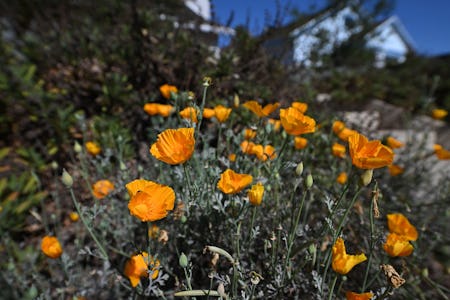Californians Are Getting Paid To Rip Out Their Lawns To Fight Climate Change
Say goodbye to your lawnmower; you could get paid to embrace climate friendly, native plant-covered lawns.

Water departments throughout the California have decided it’s time to take stronger measures to address worsening drought conditions across the state. Around 50% of the Golden State’s 409 water agencies are offering cash to homeowners who rip out their lawns and install water friendly landscaping.
According to data compiled for The National Turfgrass Research Initiative, there are more than 50,000,000 acres of grass in the U.S., making it the most irrigated “crop” in the nation, surpassing even wheat and corn. Those numbers are bad for California’s water reserves, which have been in decline from climate change-driven drought for years. A recent study found that the western part of the country is actually in the midst of the worst drought in 1,200 years.
Targeting lawns makes a lot of sense: Per CNN, maintaining and keeping “front lawn grass alive requires up to 75% of just one household’s water consumption.”
So, to help curtail the water shortage crisis, district water agencies are promoting lawn removal and putting cash in the pockets of residents who jump on board — up to $6 per square foot, in some cases.
To qualify for the cash, residents must complete an application and agree to replace their lawn with water friendly landscaping — drought-resistant plants, storm water systems such as rain barrels, and permeable hardscapes that allow rainwater to seep into the earth and not run off into municipal storm drains.
All in all, the programs have been a hit. When Rancho Mirage City Councilors voted in May to allocate $50,000 to fund the rebates, there was so much interest that they ran out of cash almost immediately and voted to up the fund to $1.5 million.
Residents with large lawns are getting big payouts. According to reporting by CNN, one Rancho Mirage resident removed his 4,000 square foot lawn to the tune of a $24,000 payday — though the homeowner did pay more than $40,000 for landscaping to replace the lawn.
Drought conditions in California and elsewhere in the west are taking their toll on local reservoirs and the large bodies of water that feed them. The Colorado River, which provides water for 40 million people throughout the Southwest, is at record lows. This has prompted the federal government to declare a Tier 2 water shortage for the area. The Colorado River also feeds Lake Mead and Lake Powell, which produce hydroelectric energy for the entire region. If reservoir levels continue to drop, the dams will not be able to produce power.
The Tier 2 water emergency requires that states decrease water consumption by as much as 20% to remain compliant and not put the river at dangerously low levels.
Turfgrass removal provides other ecological benefits as well. Lawns generally consist of non-native plants that are mowed before they can flower, which is bad for bees and other pollinators and removes all biodiversity from the area. Getting rid of these large swathes of monoculture and replacing them with native plants that are hardy and can withstand regional climate differences without needing water or fertilizer, a practice known as xeriscaping, doesn’t only help bees and bugs. It also protects the water table from fertilizer runoff, which can wreak havoc on aquatic ecosystems by encouraging the growth of invasive aquatic plants that choke out fish and other aquatic wildlife.
Plus, if you like to keep your weekends lazy, you can retire that lawnmower and relax in your water friendly, bee friendly, Earth friendly yard.